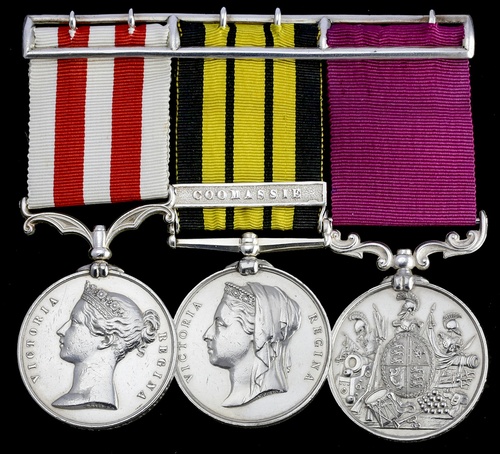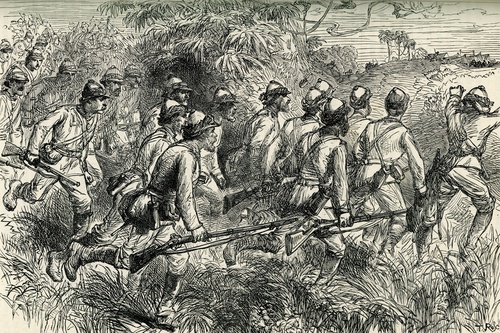Auction: 18002 - Orders, Decorations and Medals
Lot: 335
‘A few minutes before 8 a.m. [on 31 January 1874], the firing began, and soon after, the white smoke was spouting, and the red musketry flashing, amid the dark bush in every direction. Breaking into skirmishing order, at a quick run, the 42nd Highlanders attacked the village [of Amoaful] … each company of Highlanders threw forward three sections of skirmishers, the fourth sections acting as supports as they advanced against an unseen foe … It was fortunate, says the ‘Daily News’ correspondent, that the enemy were using slugs, and not bullets, ‘or scarcely a man of the Black Watch would have lived to tell the tale. As it was there were few of the officers who did not receive a scratch.’
Major Baird was severely wounded; Major Macpherson was hit in several places, yet remained under fire propped up on a stick. In a very few minutes 105 Highlanders – nine being officers – were struck during a pause and delay, while it seemed alike impossible to subdue the blinding fire of the Ashantees, and to advance over the marshy ground, and to make at them that rush which was necessary to drive them back.
‘There is something very unpleasant about shots that come suddenly out – sometimes singly, sometimes in loud and continually repeated bursts - from places that a moment before gave no indication of human life; but when, in addition to this, the ground became so marshy that, in the movement forward, every step seemed to disclose the position of our men to the perfectly concealed foe, the situation was trying.’
Amid this storm of shot which swept through the bush, shredding away showers of twigs and leaves, lay poor Captain Buckle, of the Engineers – an officer of untiring zeal and energy – expiring with two slugs in the region of his heart. Around him was a group of 42nd men, all more or less wounded, their grey uniforms covered with gouts of blood, while the doctors were hard at work extracting the lacerating slugs, and applying pads and bandages … ’
British Battles on Land and Sea, by James Grant, refers.
A scarce Victorian campaign group of three awarded Quarter-Master Sergeant J. McLean, 42nd Highlanders, who was severely wounded by a gunshot in the face at Amoaful on 31 January 1874
Indian Mutiny 1857-59, no clasp (Drumr. Jas. McLean, 42nd Highlanders); Ashantee 1873-74, 1 clasp, Coomassie (4321 Cr. Serjt. J. McLean, 42nd Highds. 1873-4); Army L.S. & G.C., V.R., small letter reverse (4321 Sergt. J. McLean, 42nd Foot), mounted for wear from an old riband buckle bar, the first two with contact marks and edge bruising, and the second with tightened suspension claw, good fine or better, the last very fine and a scarce combination of awards (3)
James McLean was born at Comrie, Perthshire in March 1842 and enlisted in the 42nd Highlanders as a drummer boy in June 1856. He quickly witnessed active service in the Indian Mutiny (Medal).
He subsequently gained steady advancement to the rank of Colour-Sergeant in October 1870, in which rank he served in the Ashantee War of 1873-74. Severely wounded by a gunshot to his face at the battle of Amoaful on 31 January 1874 - he suffered the loss of his right eye – Mclean also received a less serious wound in his left shoulder.
He was transferred to the Royal Perthshire Militia as a Quarter-Master Sergeant in 1875 and was finally discharged to a pension in April 1879, the same year in which he was awarded his L.S. & G.C. Medal; sold with copied service papers and other research.
Subject to 20% VAT on Buyer’s Premium. For more information please view Terms and Conditions for Buyers.
Sold for
£1,500







